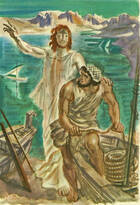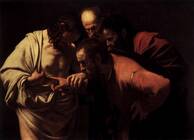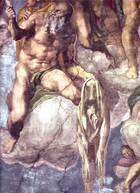
Papa Benedict XVI's Catecheses on the Twelve Apostles
given at his Wednesday Audiences
The Apostle St Peter, the Fisherman 
BXVI: "Peter thus learnt what it means to truly follow Jesus. It is his second call, analogous to the call of Abraham in Genesis 22, after that of Genesis 12: "If any man wishes to come after me, let him deny himself, take up his cross and follow me. Because whoever wants to save his life, will lose it; but whoever loses his own life for my sake and that of the Gospel, will save it" (Mk 8, 34-35). It is the demanding law of following Christ: the need to know how to renounce, if necessary, the whole world so as to save true values, to save one's soul, to save the presence of God in the world (cf Mk 8, 36-37). Even if with difficulty, Peter welcomes the invitation and continues his pathway in the footsteps of the Master.
And it seems to me that these different conversions of St Peter and his whole figure are a great consolation and a great lesson for us. We too have a desire for God, we too want to be generous, but we too expect God to be strong in the world and to immediately transform the world according to our ideas, according to the needs that we see. God chooses a different road. God chooses the way of transformation of hearts in suffering and in humility. And we, like Peter, must always convert anew. We must follow Jesus and not precede him: it is He who shows us the way. Thus Peter tells us: You think you have the recipe and must transform Christianity, but it is the Lord who knows the road. It is the Lord who says to me, who says to you: follow me! And we must have the courage and humility to follow Jesus, because He is the Way, the Truth and the Life."
The Chair of Peter - gift of Christ to His Church 
BXVI: "The seat of Rome, after these migrations by St Peter, was thus recognized as that of the successor of Peter, and the "chair" of its bishop represents that of the Apostle instructed by Christ to graze his whole flock. The most ancient Fathers of the Church attest to this, as for example St Irenaeus, Bishop of Lyons, but who came from Asia Minor, who in his treatise Against Heresies, describes the Church of Rome as the "greatest and most ancient, known by all; ... founded and established in Rome by the two most glorious apostles, Peter and Paul"; and he adds: "With this Church, because of her eminent superiority, must be in accord the universal Church, that is, the faithful everywhere" (III, 3, 2-3). Tertullian, a little later, for his part affirms: "How blessed is this Church of Rome! It was the Apostles themselves who, in pouring out their blood, gave to her the doctrine in its totality" (The prescription of heretics, 36). The chair of the Bishop of Rome represents, therefore, not only his service to the Roman community but also his mission of guiding the entire People of God.
Thus to celebrate the "Chair" of Peter means to attribute to it a strong spiritual significance and to recognize in it a privileged sign of the love of God, the good and eternal Shepherd, who wants to gather his entire Church and guide her on the way of salvation. Among the many testimonies of the Fathers, I would like to quote that of St Jerome, taken from one of his letters, written to the Bishop of Rome, particularly interesting because it makes explicit reference precisely to the "chair" of Peter, presenting it as a safe haven of truth and peace. Jerome writes thus: "I decided to consult the chair of Peter, where is found that faith that an Apostle's mouth/lips has exalted; I now come to ask for nourishment for my soul there, where once I received the garment of Christ. I follow no other primacy than that of Christ; for this reason I put myself in communion with your beatitude, that is, with the chair of Peter. I know that on this rock is built the Church" (Letters I, 15, 1-2). .."
The Apostle St John, son of Zebedee 
BXVI: "According to tradition, John is the "beloved disciple", who in the Fourth Gospel lays his head on the Master's breast during the Last Supper (cf Jn 13, 21), stands at the foot of the Cross together with the Mother of Jesus (cf Jn 19, 25) and lastly is witness both of the empty tomb and of the very presence of the Risen One (cf Jn 20, 2; 21, 7). We know that this identification is disputed by scholars today, some of whom view him merely as the prototype of a disciple of Jesus. Leaving the exegetes to settle the matter, let us be content here to gather an important lesson for our lives: the Lord desires to make each one of us a disciple who lives a personal friendship with Him. To realise this, it is not enough to follow him and to listen to him exteriorly: it is also necessary to live with Him and like Him. This is possible only in the context of a rapport of great familiarity, imbued with the warmth of total trust. This is what happens between friends; this is why Jesus said one day: "No one has a greater love than this: to give his life for his friends.... I no longer call you servants, for a servant does not know what his master is doing; but I have called you friends, for all that I have heard from my Father I have made known to you" (Jn 15, 13. 15).
In the apocryphal Acts of John, the Apostle is presented not as the founder of Churches nor as the guide of already established communities, but in continual journeying as the communicator of faith in the encounter with "souls capable of hoping and of being saved" (18, 10; 23, 8). Everything is motivated by the paradoxical intention of making the invisible seen. And indeed he is called simply "the Theologian" by the Eastern Church, that is, the one who is able to speak of divine things in accessible terms, by revealing an arcane access to God through adherence to Jesus."
The Apostle St James the Greater 
BXVI: "We can thus learn many things from Saint James: promptness in welcoming the Lord's call even when he asks us to leave the "boat" of our human securities, enthusiasm in following him on the roads that He indicates to us beyond any of our illusory presumption, readiness to witness to him with courage, if necessary, all the way to the supreme sacrifice of life. Thus James the Greater stands before us as an eloquent example of generous adherence to Christ. He who initially, through his mother, had requested to be seated with his brother next to the Master in his Kingdom, was precisely the first to drink the chalice of the passion, to share martyrdom with the Apostles.
And, in the end, summarizing everything, we can say that the pathway, not only exterior but above all interior, from the mount of the Transfiguration to the mount of the Agony, symbolizes the whole pilgrimage of Christian life, amid the persecutions of the world and the consolations of God, as the Second Vatican Council says. By following Jesus like St James, we know, even in difficulties, that we are going on the right road."
The Apostle St Matthew the Evangelist 
BXVI: "On the basis of these simple findings that result from the Gospel, we can advance a pair of reflections. The first is that Jesus welcomed into the group of his close friends a man who, according to the concepts in vogue in Israel at that time, was considered a public sinner. Matthew, in fact, not only handled money deemed impure because of its provenance from people foreign to the people of God, but he also collaborated with a foreign and odiously greedy authority, whose tributes moreover could be determined arbitrarily. For these reasons, the Gospels more than once speak jointly of "tax collectors and sinners" (Mt 9, 10; Lk 15, 1), of "tax collectors and prostitutes" (Mt 21, 31). Furthermore, they see tax collectors as an example of meanness (cf Mt 5, 46: they love only those who love them), and mention one of them, Zacchaeus, as "a leader of tax collectors and a rich man" (Lk 19, 2), while popular opinion associated them with "extortioners, the unjust, adulterers" (Lk 18, 11). Based on these references, a first fact catches the eye: Jesus does not exclude anyone from his friendship. Rather, precisely while he is at table in Matthew-Levi's house, in response to those who expressed scandal at the fact that he associated with such disreputable company, Jesus pronounced the important statement: "It is not the healthy who need a physician, but the sick; I did not come to call the righteous but sinners" (Mk 2, 17).
The good news of the Gospel consists precisely in this: in the offering of God's grace to the sinner! Elsewhere, with the famous parable of the Pharisee and the tax collector who went up to the Temple to pray, Jesus even indicates an anonymous tax collector as an valuable example of humble trust in divine mercy: while the Pharisee is boasting of his own moral perfection, the "tax collector... did not even dare to lift his eyes to heaven, but beat his breast, saying, "O God, have mercy on me a sinner!'" And Jesus comments: "I tell you: this man returned home justified, unlike the other man, because the one who exalts himself will be humbled, but the one who humbles himself will be exalted" (Lk 18, 13-14). In the figure of Matthew, therefore, the Gospels propose to us a true and proper paradox: the one who is apparently farthest from holiness can even become a model of welcome of God's mercy and leave a glimpse of its wonderful effects in their own existence."
The Apostle St Thomas 
BXVI: "Then there is the well-known and proverbial scene of the doubting Thomas, that occurred eight days after Easter. Initially, he had not believed that Jesus had appeared in his absence, and had said: "Unless I see in his hands the print of the nails and place my finger in the mark of the nails, and place my hand in his side, I will not believe" (Jn 20, 25). At base, from these words emerges the conviction that Jesus is henceforth recognized not so much by his face as by his wounds. Thomas considers that the marks that confirm Jesus' identity are now above all his wounds, in which he reveals to what end He has loved us. In this the Apostle is not mistaken. As we know, eight days later Jesus reappeared among his disciples, and this time Thomas was present. And Jesus summons him: "Put your finger here and see my hands; stretch out your hand and place it in my side; and no longer be incredulous, but believe" (Jn 20, 27). Thomas reacts with the most splendid profession of faith in the whole of the New Testament: "My Lord and my God!" (Jn 20, 28). In this regard, St Augustine comments: Thomas "saw and touched the man, but confessed his faith in God, whom he neither saw nor touched. But what he saw and touched led him to believe in what until then he had doubted". The Evangelist continues with Jesus' last words to Thomas: "Because you have seen me, you have believed: blessed are those who have not seen and yet believe" (Jn 20, 29). This phrase can also be put in the present tense: "Blessed are those who do not see and yet believe". In any case, Jesus here enunciates a fundamental principle for Christians who will come after Thomas, thus for all of us. It is interesting to note how another Thomas, the great Medieval theologian of Aquinas, juxtaposed this formula of blessedness with the apparently opposite one recorded by Luke: "Blessed are the eyes which see what you see!" (Lk 10, 23). But, Aquinas comments: "Those who believe without seeing are much more deserving than those who believe by seeing". In fact, the Letter to the Hebrews, recalling the whole series of the ancient biblical Patriarchs, who believed in God without seeing the fulfilment of his promises, defines faith as "the assurance of things hoped for, the conviction of things not seen" (Heb 11, 1). The case of the Apostle Thomas is important for us for at least three reasons: first, because it comforts us in our insecurities; second, because it shows us that every doubt can lead to an outcome brighter than any uncertainty; and, lastly, because the words addressed to him by Jesus remind us of the true meaning of mature faith and encourage us to carry on, despite the difficulties, along our pathway of adherence to Him."
The Apostle St Bartholomew (aka Nathaniel) 
BXVI: "Returning to the scene of the vocation, the Evangelist tells us that, when Jesus sees Nathanael approaching him, he exclaims: "Behold, an Israelite indeed, in whom there is no guile!" (Jn 1, 47). This is a eulogy that recalls the text of a Psalm: "Blessed is the man... in whose spirit there is no deceit" (Ps 32, 2), but provokes the curiosity of Nathanael who replies in amazement: "How do you know me?" (Jn 1, 48). Jesus' response is not immediately comprehensible. He says: "Before Philip called you, I saw you when you were under the fig tree" (Jn 1, 48). We do not know what had happened under this fig tree. It is evident that this was a decisive moment in Nathanael's life. He feels touched in his heart by Jesus' words, he feels understood and he understands: this man knows everything about me, He knows and understands the road of life, this man I can really trust. And so he answers with a clear and beautiful confession of faith, saying: "Rabbi, you are the Son of God, you are the King of Israel" (Jn 1, 49). In this is delivered a first, important step on the journey of attachment to Jesus. Nathanael's words shed light on a twofold, complementary aspect of Jesus' identity: He is recognized both in his special relationship with God the Father, of whom he is the Only-begotten Son, and in his relationship with the people of Israel, of whom he is the declared King, precisely the description of the awaited Messiah. We must never lose sight of either one or other of these two components, because if we only proclaim Jesus' heavenly dimension we risk making him an ethereal and evanescent being, and if, on the contrary, we recognize only his concrete location in history, we end up by neglecting the divine dimension that properly qualifies him."







